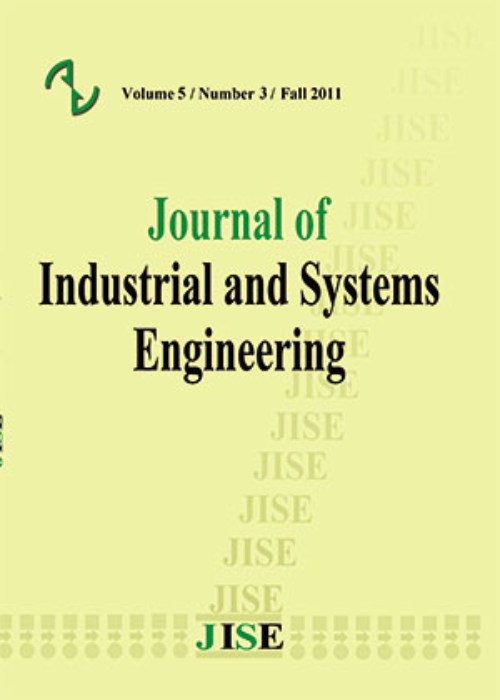فهرست مطالب

Journal of Industrial and Systems Engineering
Volume:9 Issue: 1, Winter 2016
- special issue on supply chain
- تاریخ انتشار: 1394/12/03
- تعداد عناوین: 6
-
-
Pages 1-16In this paper, an incentive policy is proposed to coordinate ordering, lead time, and pricing strategies in a two-echelon manufacturing supply chain (SC) consisting of one manufacturer and one retailer. The system is faced with a stochastic demand which depends on both price and lead time. The manufacturer decides on production size and manufacturing acceleration rate while the retailer determines the retail price and order size. A game-theory approach is proposed to analyze both members decision making process. An integrated decision making process where both members cooperate as a single entity aiming to maximize system-wide profit is formulated. Finally a coordination mechanism based on adjusting wholesale price is proposed to convince both members to decide jointly. Numerical experiments demonstrate that whole SC profitability as well as both members profitability is increased by applying the proposed scheme. Results indicate that coordinated decision making decreases both retail price and lead time length while it causes an increase in order size.Keywords: Manufacturing process acceleration, Supply chain coordination, Stochastic price, lead time, sensitive demand, Game, theory, Lead time reduction
-
Pages 17-29In this paper,we investigate the pricing and return policy issueof one-echelon green supply chain, contain a manufacture who produces two type of products: green and non-green products. These products have a same functional but in selling price and environmentally issues have different effects. Also we consider return policy for both products that can stimulate the customer valuation. We develop and analysis models of pricing strategy and return policy in both green production and hybrid production modes. System performance in both hybrid and green production mode are studied, and the return policy and its effect on these production modes in supply chain are investigated. The optimal solutions are derived and several numerical examples and sensitivity analysis are performed to demonstrate the applicability of the developed model and solution method.Keywords: Green supply chain, Return policy, Pricing, Hybrid production mode
-
Pages 30-50In this paper, bi-level programming is proposed for designing a competitive supply chain network. A two-stage stochastic programming approach has been developed for a multi-product supply chain comprising a capacitated supplier, several distribution centers, retailers and some resellers in the market. The proposed model considers demands uncertainty and disruption in distribution centers and transportation links. Then, Stackelberg game is used to formulate the competition among the component of supply chain. A bi-level mixed integer programming is used for developing a supply chain performed currently, then the impacts of the strategic facility location on the operational decisions such as inventory and shipments, have been investigated. To solve the model, we have used Benders decomposition algorithm, which is an exact algorithm for solving mixed integer programming. Finally, the outputs of the model are illustrated for investigating the efficiency of proposed model. Then, some discussions have been done through several numerical examples and some managerial insight has been suggested for the situations similar to the assumed problem.Keywords: Competition, Supply chain network design, Disruption, Benders decomposition algorithm
-
Pages 51-72Maintaining the health of people during and after a disaster is one of the most important issues in disaster management. Blood products are among the essential items needed to save the human life and the lack of them may lead to significant losses in human health. In this paper a comprehensive mathematical model of blood products supply chain is presented to respond the need for blood products in disaster situations. The proposed model is a bi-objective mixed integer programming and with respect to the unstable conditions during the disaster the uncertain parameters are modelled by fuzzy numbers. An interactive possibilistic programming approach is applied to handle the uncertainty. The developed model is implemented for the earthquake disaster case study in mega city of Tehran using blood transfusion network data. The results show the ability of the proposed model in generating effective solutions under earthquake conditions.Keywords: Blood products supply chain, Earthquake disaster, Fuzzy mathematical programming, network design, Multi, objective optimization
-
Pages 73-87Several real problems in telecommunication, transportation, and distribution industries can be well analyzed by network flow models. In revenue management, pricing plays a primary role which increases the profit generated from a limited supply of assets. Pricing decision directly affects the amount of service or product demand. Hence, in traditional maximum flow problem, we assume that the demand of sink nodes depends on price of services or products of that nodes. We first develop a mathematical programming model for decision making of pricing by multiple owners in the maximum flow problem. Afterwards, coalitions between owners will be analyzed via different methods of cooperative game theory. A numerical example is given in order to show how these methods suggest appropriate assignments of extra revenue obtained from the cooperation among the owners.Keywords: Network flow, pricing decision, flow game, cooperative game theory, coalition
-
Pages 88-107The major oil industry upstream activities include the exploration, drilling, extraction, pipelines installation, and production of crude oil. In this paper, we develop a mathematical model to plan for theseoperations as a crude oil supply chain network design problem.The proposed multi-period mixed integer linear programming model entails both strategic (e.g., facility location and allocation) and tactical (e.g., project and production planning) decisions. With the objective of maximizing total Net Present Value (NPV) at the end of planning horizon, the decisions to be made comprise the location of the facilities, the flow of commodities and the amount of investment. The uncertain natures of important input parameters such as capital and operational cost, demand and price of crude oil, are taken into account via fuzzy theory. Finally, the performance of the developed model is investigated using the real data of Iranian South Oilfields.Keywords: Crude oil supply chain, Oilfield development, Multi, period programming, Time horizon analysis, Fuzzy optimization


